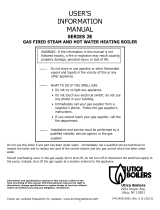
13
CHIMNEY AND VENT PIPE CONNECTION
Boiler and venting installations shall be performed
in accordance with "Venting of Equipment", of the
National Fuel Gas Code, ANSI Z223.1/NFPA 54, or
applicable provisions of the local building codes.
Chimney Inspection
Chimney must be clean, sized correctly, properly
constructed and in good condition.
Installation must conform to requirements of the authority
having jurisdiction or, in absence of such requirements, to
the National Fuel Gas Code, ANSI Z223.1/NFPA 54. See
Figure 6, page 13.
Connecting The Vent Damper And Vent Connector
Refer to Figure 1 for the size and location of the vent (ue
opening). Use a 28 gauge (minimum) galvanized pipe to
connect to the chimney.
Furnished vent damper blade has 1/2 square inch hole
(approximately 3/4” diameter). Boilers equipped with
intermittent ignition, plug hole use plug supplied with vent
damper.
1.
Position furnished vent damper on top of ue outlet
collar. Fasten damper securely to ue outlet collar
with sheet metal screws. Make sure damper blade has
clearance to operate inside of diverter. Do not modify
draft diverter or vent damper
As An Option
Damper may be installed in any horizontal or vertical
position, closer to ue outlet collar preferred. See
Figures 7, 8 and 9.
2.
Install vent damper to service single boiler only for
which it is intended. Damper position indicator shall be
in visible location following installation. Locate damper
so it is accessible for servicing.
3.
Damper must be in open position when appliance main
burners are operating.
4.
Boiler is equipped with factory wired harness that plugs
into vent damper. Connect thermostat to black wires
marked 24 volt thermostat on boiler.
5.
Vent pipe must be same size as ue outlet collar.
6.
Slope pipe up from boiler to chimney not less than 1/4”
per foot.
7.
Run pipe as directly as possible with as few elbows as
possible.
8.
Do not connect to replace ue.
9.
End of vent pipe must be ush with inside face of
chimney ue. Use sealed-in thimble for chimney
connection.
10.
Horizontal run shall be as short as possible, however
not longer than 3/4 the chimney height (HT) Figure 6,
page 14.
Vent Pipe
• Fasten sections of vent pipe with 3 sheet metal screws
at each joint to make piping rigid.
• Support horizontal portions of vent system to prevent
sagging.
• Use stovepipe wires or metal strapping every 5’ to
support pipe from above.
• Vent pipe through crawl space, use double wall vent
pipe.
• Vent pipe passing through combustible wall or partition,
use ventilated metal thimble. Thimble should be 4"
larger in diameter than vent pipe.
NOTICE
Minimum Vent Pipe Clearance - Wood and other
combustible materials must not be closer than 6” from
any surface of single wall metal vent pipe. Listed Type
B vent pipe or other listed venting systems shall be
installed in accordance with their listing.
Removing Existing Boiler From Common Venting
System
When an existing boiler is removed from a common
venting system, the common venting system is likely to be
too large for proper venting of the appliances remaining
connected to it.
At the time of removal of an existing boiler, the following
steps shall be followed with each appliance remaining
connected to the common venting system placed in
operation, while the other appliances remaining connected
to the common venting system are not in operation.
1.
Seal any unused openings in the common venting
system.
2.
Visually inspect the venting system for proper size and
horizontal pitch and determine there is no blockage or
restriction, leakage, corrosion and other deciencies
which could cause an unsafe condition.
3.
Insofar as is practical, close all building doors and
windows and all doors between the space in which the
appliances remaining connected to the common venting
system are located and other spaces of the building.
Turn on clothes dryers and any appliance not connected
to the common venting system. Turn on any exhaust
fans, such as range hoods and bathroom exhausts, so
they will operate at maximum speed. Do not operate a
summer exhaust fan. Close replace dampers.
WARNING
Installing or venting a boiler or any other gas
appliance with improper methods or materials could
result in death or serious injury due to re or to
asphyxiation from poisonous gases such as carbon
monoxide which is odorless and invisible.
!
PN 14683003, Rev. L [05/01/2019]

























